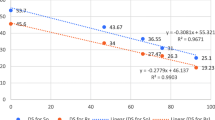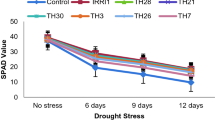Abstract
Sheath blight of rice caused by Rhizoctonia solani Kuhn is a major rice diseases worldwide, and cause up to 50% yield losses depending upon its severity. Native biocontrol agents were isolated from rice rhizospheric soil of different region and NADEP compost. Fourteen strains of Trichoderma were isolated and screened in vitro against Rhizoctonia solani causing sheath blight of rice through dual culture technique. Among all tested isolates under in vitro conditions Trichoderma BHU-11, T-4 and BHU-8 showed the maximum inhibition for Rhizoctonia solani (71.48%, 67.28% and 63.89%, respectively). These strains of Trichoderma were also taken for checking drought tolerance in rice crop. Trichoderma strains when applied as seed + root dip treatment showed reduction of disease incidence. It also acted as plant growth promoter and increased the number of tillers/hill, plant height and yield of the crop. Trichoderma alters the drought response including drought avoidance through different morpho-physiological and biochemical adaptations, and enhanced drought recovery. The root colonization by Trichoderma increased the growth of roots and plant productivity. Biochemical studies showed the ability of Trichoderma BHU-11, T-4 and BHU-8 to produce high level phenol and proline contents in Trichoderma treated stress challenged plants and higher accumulation of chlorophyll in Trichoderma treated plants.
Similar content being viewed by others
References
Abbas A, Jiang D, Fu Y (2017) Trichoderma spp. as antagonist of Rhizoctonia solani. J Plant Pathol Microbiol 8(3):1–9
Bates LS, Waldren RP, Teare ID (1973) Rapid determination of free proline for water-stress studies. Plant Soil 39(1):205–207
Bisen K, Keswani C, Patel JS, Sarma BK, Singh HB (2016) Trichoderma spp.: efficient inducers of systemic resistance in plants. Microbial-mediated induced systemic resistance in plants. Springer, Singapore, pp 185–195
Chaube HS, Sharma J (2002) Integration and interaction of solarization and fungal and bacterial bioagents on disease incidence and plant growth response of some horticultural crops. Plant Dis Res 17(1):201
De França SKS, Cardoso AF, Lustosa DC, Ramos EMLS, De Filippi MCC, Da Silva GB (2015) Biocontrol of sheath blight by Trichoderma asperellum in tropical lowland rice. Agron Sustain Dev 35(1):317–324
Doni F, Zain CRCM, Isahak A, Fathurrahman F, Anhar A, Mohamad WNAW, Yusoff WMW, Uphoff N (2017) A simple, efficient, and farmer-friendly Trichoderma-based biofertilizer evaluated with the SRI Rice Management System. Organ Agric 8:1–17
Ha TN (2010) Using Trichoderma species for biological control of plant pathogens in Vietnam. J ISSAAS 16(1):17–21
Jain RM, Mody K, Mishra A, Jha B (2012) Physicochemical characterization of biosurfactant and its potential to remove oil from soil and cotton cloth. Carbohydr Polym 89(4):1110–1116
Khan AA, Sinha AP (2005) Comparative antagonistic potential of some biocontrol agents against sheath blight of rice. Indian Phytopathol 58(1):41–45
Kotasthane A, Agrawal T, Kushwah R, Rahatkar OV (2015) In-vitro antagonism of Trichoderma spp. against Sclerotium rolfsii and Rhizoctonia solani and their response towards growth of cucumber, bottle gourd and bitter gourd. Eur J Plant Pathol 141(3):523–543
Kumar A, Dixit S, Ram T, Yadaw RB, Mishra KK, Mandal NP (2014) Breeding high-yielding drought-tolerant rice: genetic variations and conventional and molecular approaches. J Exp Bot 65(21):6265–6278
Lattanzio V, Lattanzio VM, Cardinali A (2006) Role of phenolics in the resistance mechanisms of plants against fungal pathogens and insects. Phytochem Adv Res 661(2):23–67
Pandey V, Ansari MW, Tula S, Yadav S, Sahoo RK, Shukla N, Bains G, Badal S, Chandra S, Gaur AK, Kumar A (2016) Dose-dependent response of Trichoderma harzianum in improving drought tolerance in rice genotypes. Planta 243(5):1251–1264
Petridis A, Therios I, Samouris G, Koundouras S, Giannakoula A (2012) Effect of water deficit on leaf phenolic composition, gas exchange, oxidative damage and antioxidant activity of four Greek olive (Olea europaea L.) cultivars. Plant Physiol Biochem 60:1–11
Pirdashti H, SarvestaniTahmasebi Z, Nematzadeh GH, Ismail A (2003) Effect of water stress on seed germination and seedling growth of rice (Oryza sativa L.) genotypes. Pak J Agron 2:217–222
Salton NA, Cartwright RD, Jie Meng, Gbur EE, Noman RJ (2003) Sheath blight severity and rice yield as affected by nitrogen fertilizer rate, application method and fungicide. Agron J 95(6):1489–1496
Sharma KK, Zaidi NW, Singh US (2012) Effect of biological seed treatment on seed germination and growth promotion of paddy, tomato and mustard. Vegetos 25(2):375–386
Silva EJNL, Herrera DR, Almeida JFA, Ferraz CCR, Gomes BPFA, Zaia AA (2012) Evaluation of cytotoxicity and up-regulation of gelatinases in fibroblast cells by three root repair materials. Int Endod J 45(9):815–820
Sumanta N, Haque CI, Nishika J, Suprakash R (2014) Spectrophotometric analysis of chlorophylls and carotenoids from commonly grown fern species by using various extracting solvents. Res J Chem Sci 4(9):63–78
Uppala S, Zhou XG (2018) Rice sheath blight. Plant Health Instr. https://doi.org/10.1094/PHI-I-2018-0403-01
Vendruscolo ECG, Schuster I, Pileggi M, Scapim CA, Molinari HBC, Marur CJ, Vieira LGE (2007) Stress-induced synthesis of proline confers tolerance to water deficit in transgenic wheat. J Plant Physiol 164(10):1367–1376
Zaidi NW, Dar MH, Singh S, Singh US (2014) Trichoderma species as abiotic stress relievers in plants. In: Gupta VK, Schmoll M, Herrera-Esterella A, Druzhinina I, Upadhyay RS, Tuohy M (eds) Biotechnology and Biology of Trichoderma, 1st edn. Elsevier, New York, pp 515–525. https://doi.org/10.1016/B978-0-444-59576-8.00038-2
Zaidi NW, Mandhata Singh, Santosh Kumar, Sangle UR, Rajeev Singh, Rameshwar Prasad, Singh SS, Singh S, Yadav AK, Ajeet Singh, Waza SA, Singh US (2017) Trichoderma harzianum improves the performance of stress-tolerant rice varieties in rainfed ecologies of Bihar, India. Field Crop Res 220:97–104
Zhang YJ, Xie ZK, Wang YJ, Su PX, An LP, Gao H (2011) Effect of water stress on leaf photosynthesis, chlorophyll content, and growth of oriental lily. Russ J Plant Physiol 58(5):844
Zheng Z, Shetty K (2000) Solid-state bioconversion of phenolics from cranberry pomace and role of Lentinus edodes β-glucosidase. JAgric Food Chem 48(3):895–900
Author information
Authors and Affiliations
Corresponding author
Additional information
Publisher's Note
Springer Nature remains neutral with regard to jurisdictional claims in published maps and institutional affiliations.
Rights and permissions
About this article
Cite this article
Mishra, D., Rajput, R.S., Zaidi, N.W. et al. Sheath blight and drought stress management in rice (Oryza sativa) through Trichoderma spp.. Indian Phytopathology 73, 71–77 (2020). https://doi.org/10.1007/s42360-019-00189-8
Received:
Revised:
Accepted:
Published:
Issue Date:
DOI: https://doi.org/10.1007/s42360-019-00189-8




